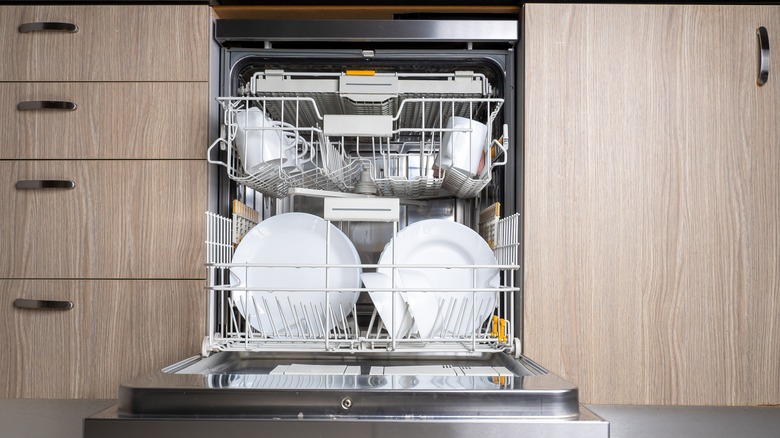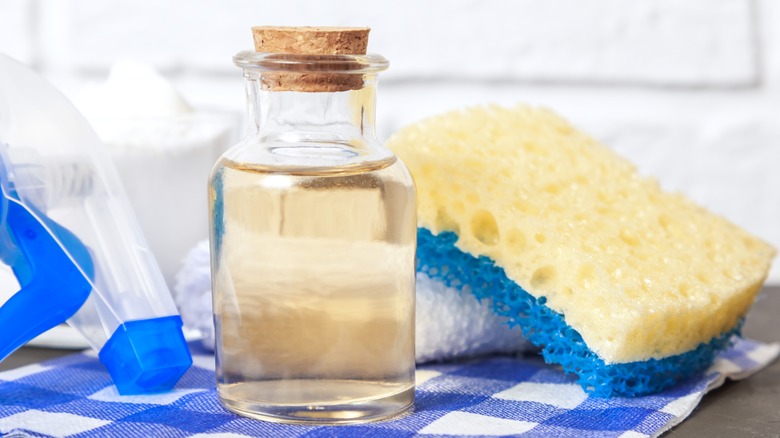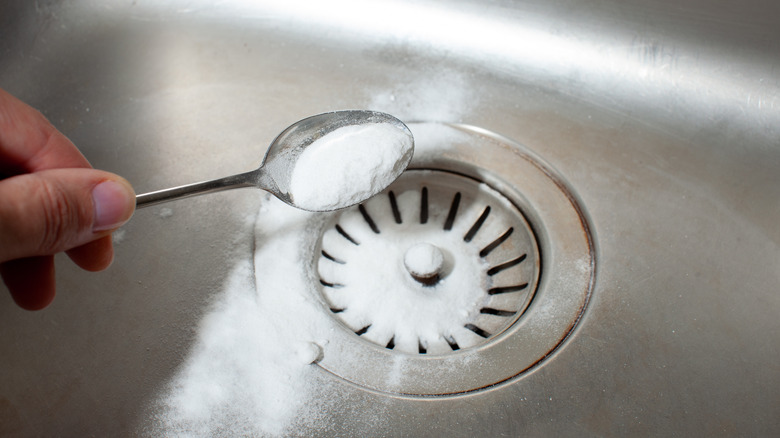The Best Way To Unclog Your Dishwasher
A dishwasher that works properly is essential. According to Grand Appliance and TV, the average dishwasher holds at least 12 complete table settings, and hand-washing a comparable amount would use five times more water, per Express Sewer & Drain. However, opening your dishwasher only to find a pool of dirty, soapy water instead of squeaky clean dishes is enough to make you scream. Standing water is a sign of a clog, along with gurgling, shaking, excessive noise, and poorly cleaned dishes. Problems can originate in the dishwasher's filter, drain, or air gap. Fortunately, there are several methods to solve this problem short of summoning a plumbing pro.
The best way to unclog your dishwasher may actually be to call upon two household cleaning reliables: vinegar and baking soda. Both are powerful natural drain cleaners, effective for dissolving all but the most serious clots. Using vinegar and baking soda to unclog a filter or drain will prevent hours spent on hand-washing cookware. They will also lessen scalded and wrinkled hands, avoid water being splashed all over, and prevent dropped dishes. Not to mention the DIY dollars saved.
Safely removing dishwasher obstructions
For safety's sake, first, disconnect the appliance and disable the appropriate circuit breaker before troubleshooting and fixing any problems. Remove dishes and utensils before getting to work on the clog, and empty the standing water in order to make the drain accessible. You can get rid of the pooled water by using a wet vac, a cup for bailing, paper towels, or even a turkey baster.
To fight mild drain clogs, Homedit suggests placing a dishwasher-safe container filled with a cup of white distilled vinegar onto the appliance's top rack. Avoid pouring the liquid directly into the detergent cup to protect the rubber gaskets and metal parts from the harsh acetic acid. Use a quick cycle setting to spread the vinegar through the dishwasher. Asurion cautions that an overly clogged drain might withstand the vinegar treatment and need to be repeated.
To clean the filter of the dishwasher and break up blockages there, Cabrillo recommends sprinkling baking soda and vinegar down the drain outlet and letting it stew for up to 15 minutes. Pivotal Home Solutions then suggests following up with boiling water. The trio of vinegar, baking soda, and hot water should be enough to clear the clogged drain hose or pipe.
Vinegar and baking soda for maintenance
Vinegar and baking soda also work to prevent dishwasher clots from forming in the first place. A monthly deep cleaning routine using vinegar will reduce clog-creating scale, food buildup, residual soap, and grime, explains Boat Basin Cafe. Be sure to never mix vinegar with bleach or with dishwashing detergent to avoid a potentially toxic combination. As effective as vinegar is in dissolving clogs, it is too harsh for everyday use in a dishwasher. Per Pick Hose, also avoid using Drano, whose sodium hydroxide component can be harmful to the PVC elements in a dishwasher.
The Maids recommends spraying a 1-to-3-part mixture of vinegar and water on a dishwasher's stainless steel exterior to clean it and remove discolorations. They also suggest rubbing a baking soda paste on crevices and underneath seals to combat mildew if the appliance has an odor. Baking soda is an effective follow-up to vinegar to double the cleaning and clog-busting power. If these methods are ineffective, however, Whirlpool suggests that a clogged drain might have been caused by faulty plumbing installation or inept service, which would require professional assistance.


